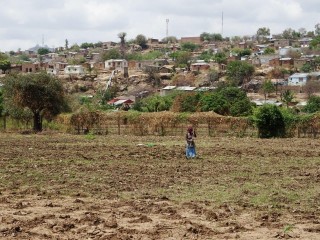Project Results:
The water supply of the Provincial Town of Tete is mainly based on two well fields in a former branch of the Zambeze River, called the Nhartanda or Nyalutande Valley. The Nitrate levels in the groundwater are deteriorating, mainly because of the inflow of Nitrogen rich waste water from the inhabited surrounding slopes. The project is a pilot to reduce the inflow of Nitrogen and to change behaviour of the surrounding population to better manage their waste and stop the practice of brick making which is reducing the impermeable top layer.
A pilot area was selected in one of the sub-catchments (Nhatsato) draining to the valley close to one of the well fields. Apart from awareness raising, several interventions were made by the construction of sanitation facilities for one school and surroundings at the edge of the valley, and tree planting and beautification of some public spaces. A third intervention was to make small check dams in the stream, that would create upstream sand bodies that could reduce the Nitrogen content in the water. At the end of project, the contracts were ready for dam construction, but had to wait the dry season. The beautification/tree planting was not successful; first through vandalism and theft, and later because of flooding and lack of weed control.
Impact of the activities on Nitrate pollution is difficult to measure at this stage.
At the end of contract € 95,731 of the total contracted subsidy of € 100,000 was used, while the other € 100,000 from the Netherlands Embassy support was to a large part still available for remaining works. These will also include a small treatment pond.
Key results
- 3 sanitation blocks constructed reaching 700 pupils and 300 community members
- Design and contracts for check dams made
- Over 5,000 trees planted, but few survived
Tips for the future
- Integrated interventions with Municipality require projects of long duration and be well integrated in the urban planning
- This type of projects can only flourish if there are active community groups that act as ‘problem owners’ such as youth groups or environmental groups.
Potential for growth
The Nhatsatu sub-catchment could become a demo-area for landscape based urban planning, but only if the other works are implemented and when community behavior will show a real change.
Project partners
ARA-Zambeze, Municipality of Tete, Landscape Studio, Waterschap De Dommel, FACE/FUSP
Period
October 2017 - November 2019
Last project updates
Background
Fast urban growth of the city of Tete and poor sanitation facilities in the informal settlement form a hazard for the quality of the groundwater. This is also the case for the aquifer of the so called Nhartanda Valley, which is used for the drinking water supply of part of the city. The Nhartanda Valley is an old branch of the Zambeze river and situated near the center of the city of Tete. ARA-Zambeze is the responsible institution for the management of water resources, including groundwater. The Municipality of the city of Tete is responsible for urban planning and enforcement of these plans. Both organizations are collabarating since 2014 to implement measures and actions to avoid the pollution of the Nhartanda Valley aquifer. The action plan for this purpose has been approved by the Municipal Assembly in 2017 and involves other parties like e.g. the drinking water company FIPAG.
The protection of the groundwater is a complex process and involves technical measures, communication, community involvement, legal instruments. As there is limited experience on succesful approaches, an experimental approach with constant monitoring is appropriate. The philosophy of the Nhartanda Verde project fits in this approach.
Project Plan
A detailed plan for the implementation of the project will become available after conclusion of the *inception phase* of the project
Target group
- Inhabitants of the Matemba Neighbourhood
- Potential care takers / service providers of the public sanitation
Sustainability
+ Induce ownership by the Matemba community of the public spaces and sanddam, by their involvement in site selection, construction and maintenance
+ The neighbourhood community will get a stake in the sand dams by the opportunity to use the upstream area for urban agriculture
+ Design and construction for robust and low maintance infrastructure
+ Involvement of the municipality as owner of the public sanitation units
+ Management contract with private operators for operation and maintenance of the sanitation units
+ Awareness of the formal neighbourhood authorities by their involvement in all stages of the project
Overview of Goals
Forestation (partial) of the Nhartanda Valley to avoid actvities and soil use that pollute the aquifer.
Upgrade of 4 public spaces to Pocket Parks, including public sanitation facilities
Construction of 4 sand dams to intercept and biologically treat waste water
Results and indicators
- Improved quality of the public space in the neighbourhoud Matemba.
- Number of pocket parks realized
- Nutrient concentration
- Conentration of Nitrate, comparing upstream and downstream of the sand dams
- Reduced contamination of the groundwater of the Nhartanda Valley by nitrates and coliforms from faeces and urine
- Number of sand dams constructed
- Nutrient load
- Concentration of Nitrate in water, comparing upstream and downstream of the sand dams
- Forestation of the Nhartanda Valley
- Number of trees plantes
- Improved sanitation
- Number of public sanitation facilities realized
